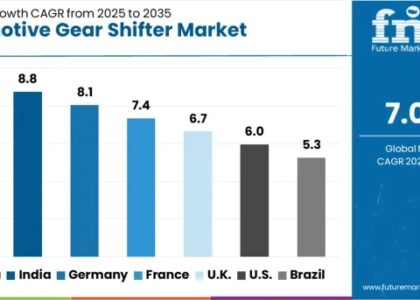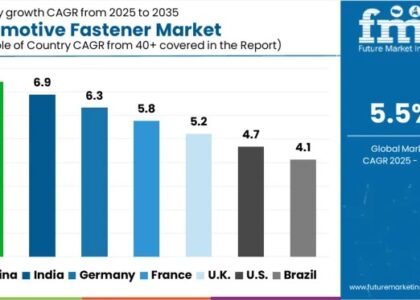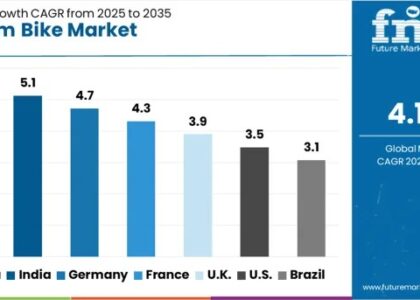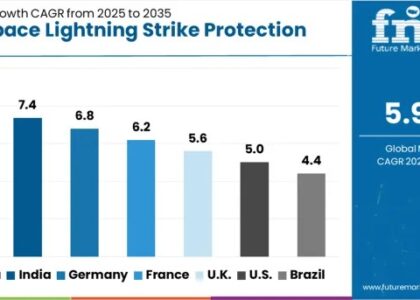The global packaging film market is set to witness significant growth, with a projected Compound Annual Growth Rate (CAGR) of 4.1% from 2023 to 2033. In 2023, the market is estimated to be valued at US$ 149.6 billion, soaring to US$ 223.5 billion by 2033.
Driving Forces Behind Market Expansion
Consumer disposable income, urbanization trends, and the growing demand for packaged foods are pivotal factors fueling the expansion of the packaging film market, particularly in emerging economies.
The burgeoning e-commerce industry, coupled with increased demand for consumer goods and health products, is driving the demand for packaging films. Furthermore, the rise in investment in the food delivery sector and the proliferation of food delivery services are key drivers of market growth.
Request for PDF Sample: https://www.futuremarketinsights.com/reports/sample/rep-gb-14376
Exploring Lucrative Market Opportunities
Manufacturers are presented with ample opportunities to develop and market biodegradable, compostable, and recyclable packaging films, aligning with the growing emphasis on environmentally friendly packaging solutions. With consumers increasingly conscious of environmental issues, there is a rising demand for eco-friendly alternatives, providing a substantial opportunity for market players to capture market share.
Moreover, the food and beverage sector offers significant prospects for packaging film manufacturers. The surge in demand for ready-to-eat meals, convenience foods, and portable snacks has heightened the need for films with superior barrier properties, extended shelf lives, and enhanced food safety. The popularity of premium and gourmet products has further fueled demand for high-end and aesthetically pleasing packaging films.
Key Market Trends
- Sustainable packaging films are gaining traction as environmental awareness among consumers continues to rise.
- High-performance films are witnessing increased popularity, driven by the expanding market for flexible packaging.
- The packaging of food and beverages has witnessed a surge in advanced barrier films, enhancing product preservation and safety.
Request Report Methodology: https://www.futuremarketinsights.com/request-report-methodology/rep-gb-14376
Business Growth Opportunities:
- Biodegradable Packaging Films: As environmental concerns grow, there’s a rising demand for sustainable packaging solutions. Biodegradable films offer an opportunity for manufacturers to tap into the eco-friendly market segment.
- Smart Packaging Films: Incorporating smart technologies like RFID, NFC, or QR codes into packaging films allows for enhanced traceability, security, and interactive consumer experiences, thereby adding value to the packaging industry.
- Flexible Packaging Films: With the trend towards convenience and on-the-go lifestyles, flexible packaging films are gaining popularity due to their lightweight nature, ease of use, and cost-effectiveness.
- Anti-Microbial Films: In light of recent health crises and heightened awareness of hygiene, there is an increasing demand for packaging films with anti-microbial properties, especially in food and medical sectors.
- High-Barrier Films: Advanced packaging films with high-barrier properties provide longer shelf life and better protection against external factors such as moisture, oxygen, and UV radiation, catering to the needs of sensitive products and extending their market reach.
- Nanotechnology: The integration of nanotechnology in packaging films enables properties such as enhanced barrier performance, antimicrobial activity, and smart functionalities, driving innovation and product differentiation.
- E-commerce Packaging: With the rise of e-commerce, there’s a growing demand for packaging films optimized for online retail, including features like tamper-evident seals, puncture resistance, and compactness to reduce shipping costs and environmental footprint.
Request For Customization: https://www.futuremarketinsights.com/customization-available/rep-gb-14376
Key Takeaways
- The United States may control 20% of the packaging films market.
- From 2023 through 2033, Germany maintained its 4.4% market share.
- Japan may control 5.8% of the packaging films industry.
- From 2023 to 2033, Australia held a 1% market share for packaging films.
- The Chinese packaging films market is expected to record a 5.8% CAGR until 2033.
- The India packaging films industry is expected to register a 6.4% CAGR between 2023 and 2033.
- The packaging films market in the United Kingdom is expected to thrive at a 2.9% CAGR between 2023 and 2033.
- From 2023 to 2033, the Polypropylene (PP) subcategory of the material type category might have a market share of 23.3%.
- The food segment in the end-use category may account for 33.5% of the market share between 2023 and 2033.
Packaging Films Market By Category
By Material Type:
- Polyethylene (PE)
- Polypropylene (PP)
- Polyethylene Terephthalate (PET)
- Polyvinyl Chloride (PVC)
- Polyamide (PA)
- Ethyl Vinyl Alcohol (EVOH)
- Polyvinylidene Chloride (PVDC)
- Bioplastics
- Others
By Product Type:
- Pouches
- Bags & Sacks
- Tubes
- Liners
- Sachets & Stick Packs
- Tapes & Labels
- Wraps/Rolls
By End Use:
- Food
- Meat, Seafood, and Poultry
- Ready to Eat Meals
- Dairy Products
- Bakery and Confectionery
- Other Food Products
- Beverages
- Alcoholic Beverages
- Non-Alcoholic Beverages
- Homecare Products
- Personal Care Products
- Healthcare Products
- Electronics & Electricals
- Other Industrial Goods
By Region:
- North America
- Latin America
- Europe
- The Middle East and Africa
- East Asia
- South Asia
- Oceania
Author
Ismail Sutaria (Lead Consultant, Packaging and Materials) has over 8 years of experience in market research and consulting in the packaging & materials industry. Ismail’s strength lies in identifying key challenges faced by the client and offering logical and actionable insights to equip the clients with strategic decision-making power.
Ismail has been an instrumental part of several transformational consulting assignments. His key skills include competitive benchmarking, opportunity assessment, macroeconomic analysis, and business transformation advisory. Ismail is an MBA holder in Marketing and has a Bachelor’s Degree in Mathematics.
About Future Market Insights (FMI)
Future Market Insights, Inc. (ESOMAR certified, recipient of the Stevie Award, and a member of the Greater New York Chamber of Commerce) offers profound insights into the driving factors that are boosting demand in the market. FMI stands as the leading global provider of market intelligence, advisory services, consulting, and events for the Packaging, Food and Beverage, Consumer, Technology, Healthcare, Industrial, and Chemicals markets. With a vast team of over 400 analysts worldwide, FMI provides global, regional, and local expertise on diverse domains and industry trends across more than 110 countries.
Contact Us:
Future Market Insights Inc.
Christiana Corporate, 200 Continental Drive,
Suite 401, Newark, Delaware – 19713, USA
T: +1-845-579-5705
For Sales Enquiries: sales@futuremarketinsights.com
Website: https://www.futuremarketinsights.com
LinkedIn| Twitter| Blogs | YouTube





